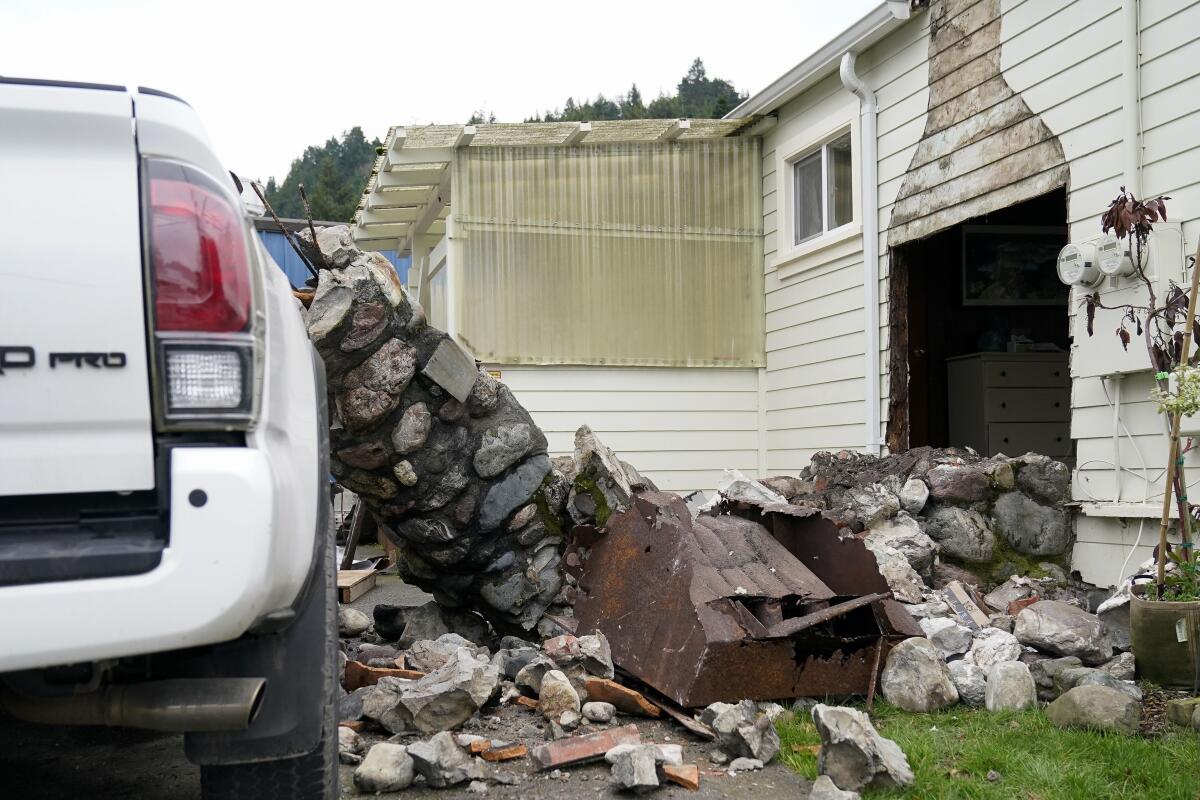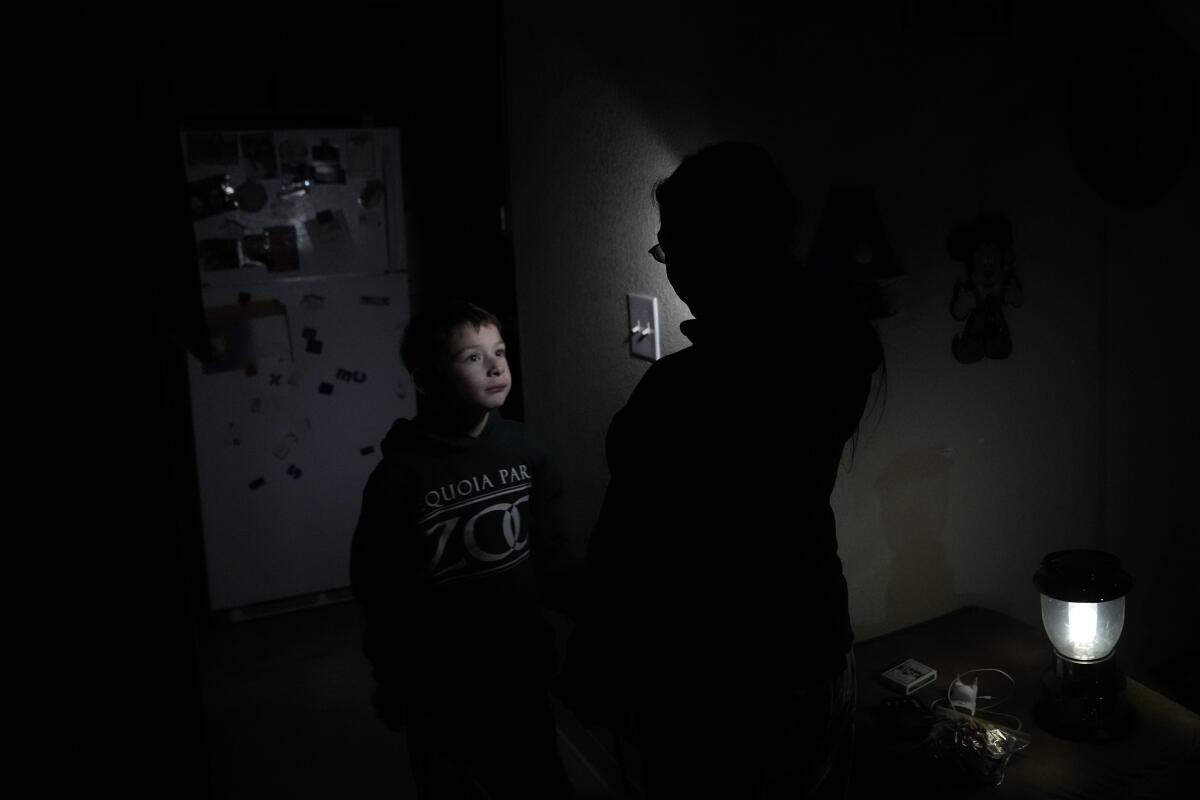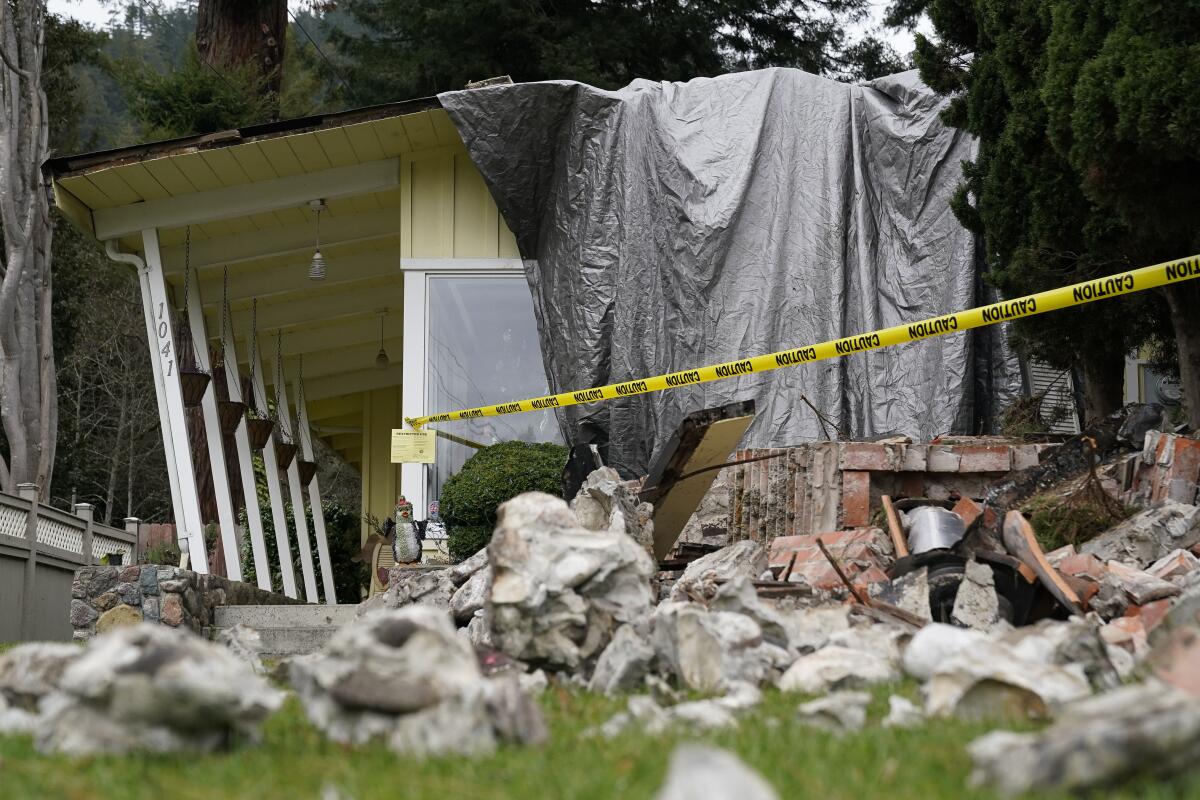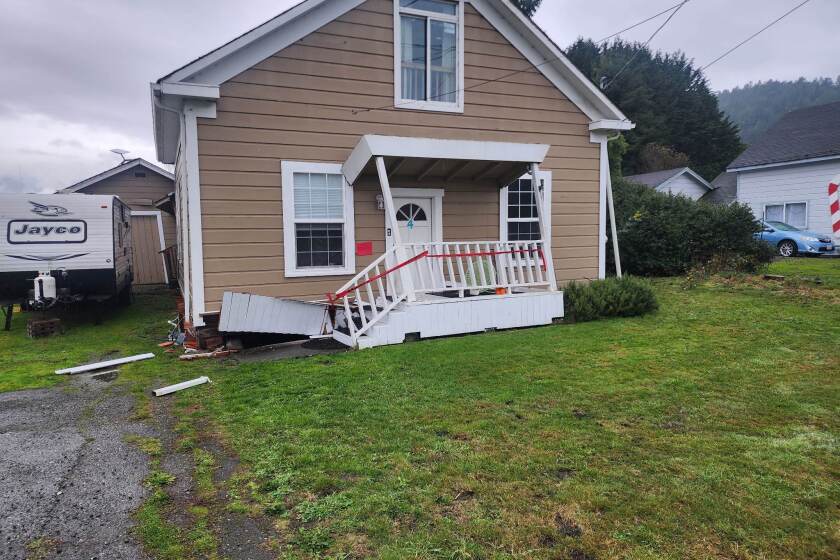Northern California towns tally earthquake damage as power is restored to tens of thousands

- Share via
One day after a magnitude 6.4 earthquake rocked Humboldt County, power was restored to tens of thousands of residents as authorities continued to survey the damage in coastal Northern California.
By Wednesday night, crews restored service to “essentially all” of the 71,000 customers who had lost electricity because of the quake, said Megan McFarland, spokesperson for Pacific Gas & Electric Co.
At least two people died because of medical emergencies during or immediately after the temblor, according to the Humboldt County Sheriff’s Office, which said both had preexisting conditions that were “believed to have been exacerbated by the stress of the earthquake.” The New York Times reported the victims were 72 and 83.
At least 17 people sustained injuries, including broken bones and head trauma, largely from furniture or appliances toppling over, officials said.
The earthquake struck offshore just after 2:30 a.m. Tuesday, about 7½ miles southwest of Ferndale, according to the U.S. Geological Survey. State officials said the ShakeAlert early warning system broadcast an alert up to 10 seconds in advance of the shaking to the mobile phones of some 3 million people in Northern California, giving residents the opportunity to drop, cover and hold or get to a place of safety.
But many were still rattled, particularly those along the quake’s fault, who almost uniformly described the event as the most violent jolt they’ve experienced in decades.
Pictures showed homes with walls and ceilings caved in, cabinets toppled over, shelves dismantled and debris covering the floors.
The quake was a “big one,” said Lucy Jones, a renowned Caltech seismologist and founder of the Dr. Lucy Jones Center for Science and Society.
No stranger to hardship in an economy sustained mostly by the dairy and timber, Ferndale and Rio Dell residents are accustomed to relying on one another.
But it’s not just an earthquake’s magnitude that determines the potential for damage; it’s also how close towns are to the fault, she said. Though the epicenter of Tuesday’s temblor was just offshore, it ruptured along a fault onshore and traveled northeast. The aftershock distribution measured about 12 miles, or 20 kilometers, which is the likely length of the fault, Jones said.
“That means you’ve got 20 kilometers’ worth of people potentially on top” of the fault, Jones said.
The quake damaged critical infrastructure, including water and gas lines. In Rio Dell, one of the hardest-hit communities, about 3,400 residents were without water Wednesday, according to the Sheriff’s Office. Authorities issued a boil-water advisory for the city and parts of nearby Fortuna.
The water had been shut off because of significant damage to the system and to preserve existing supplies in case of fires, Rio Dell Mayor Debra Garnes said.

By Wednesday night, there were signs of improvement, Garnes said. Electricity was back on and 20% to 25% of water service was restored.
But the cleanup and rebuilding work is far from over.
“It’s going to be a tough road,” Garnes said.
A significant number of Rio Dell residents don’t have earthquake insurance, which will complicate efforts to get them help if they decide to rebuild damaged homes, the mayor said.
For now, city officials are concentrating on immediate health and safety needs such as inspecting all buildings to determine which are safe to occupy, Garnes said.
The mayor praised the efforts of local and state officials but said communication was particularly difficult Wednesday as the city was left without reliable internet and phone service.
“It’s been really tiring, but it makes you proud to be part of [a] community that can pull it together, hold it together,” she said.
More than 3 million people were notified by phone early Tuesday of a 6.4 magnitude earthquake that shook Northern California.
Gov. Gavin Newsom declared a state of emergency Tuesday for Humboldt County, granting it state disaster resources and requesting federal assistance, and Sheriff William Honsal declared a local emergency.
At least 30 residences and one commercial structure have been determined structurally unsafe, the Sheriff’s Office said. The total cost of damage has not yet been determined.
Fernbridge, a Humboldt County landmark that was built across the Eel River in 1911 to connect Ferndale to U.S. 101 via State Route 211, was fractured in several places and closed for repairs, but it was likely to reopen Wednesday night, according to the California Department of Transportation’s District 1, which includes Humboldt County.
The damage was mostly cosmetic, and repair work underneath the bridge and to its sides will likely continue even after traffic resumes, said Myles Cochrane, spokesperson for Caltrans District 1.
Arcata Mayor Sarah Schaefer said that the city fared “pretty well” during the quake compared with Eureka, Ferndale, Fortuna and Rio Dell.
“We didn’t really have any damage to water and gas infrastructure,” she said. “A few broken windows around town. I’ve seen pictures of people’s stuff off the walls but nothing major in Arcata.”

Power was restored to Arcata residents Tuesday evening, according to Schaefer.
“We had a building inspector doing inspections, but I believe we sent them to Fortuna to help them because they were way more overwhelmed with damage than we were,” she said.
Diana McIntosh, a Humboldt County resident for about 65 of her 69 years, said she knew immediately to duck for cover when the shaking started.
She was asleep when she heard a crash in the front of her Eureka apartment, then the lights went out. She started screaming under the covers.
“I’d never reacted like this to an earthquake before,” McIntosh said. “It’s been scary, but this one was really much louder and noisier.”
A house listed for sale in Rio Dell, Calif., suffered significant structural damage in Tuesday’s earthquake.
McIntosh said a hutch containing 1900s-era glassware broke and her china was destroyed.
“I thought I was going to be able to pass that down to my daughter and grandchildren, but this being Humboldt County, you can’t always tell,” she said.
The county is a hotbed of seismic activity because of its numerous faults and location near the Mendocino triple junction, a complex geological area where several plates — the Gorda, the Pacific and the North American — intersect. It has been responsible for the overwhelming majority of Humboldt’s earthquakes, said Lori Dengler, a geophysicist and professor emeritus at Cal Poly Humboldt.
Tuesday’s epicenter was likely on the Gorda plate, officials said.
Though the earthquake was similar in magnitude to an offshore jolt that struck exactly a year earlier, they ruptured differently, Dengler said. Tuesday’s quake pushed its energy north, with residents as far as Seattle feeling some vibrations, but appeared weaker south of the epicenter.
Earthquakes
More resources
— One of the most important things you can do to prepare for an earthquake is talk to your neighbors, writes seismologist Lucy Jones.
— Thinking of buying a premade earthquake kit? We unboxed four of them, from $30 to $300.
— If all you have to eat in your emergency kit are granola bars and canned tuna, here’s how to up your game. Plus here’s some advice from L.A. food people.
— How does California’s earthquake early-warning system work? And what apps should you have on your phone?
She also called the ground acceleration, or how fast the speed of the ground changes, “astounding” and likely to be some of the most intense in the state’s history. A bridge near Rio Dell recorded nearly 1½ times gravitational force, enough to “make you fly into the air a little bit,” she said. It could have produced major damage had the bridge not been built to code.
But earthquakes in the area are often not catastrophic, Dengler said, as Humboldt is not a densely packed community of older buildings. Before Tuesday, the county recorded only two earthquake-related deaths in 1850.
The area’s rural nature can complicate damage assessment, and solid statistics can take weeks to collect with a lack of local engineers and limited access, she said.
Humboldt County is known for its dense forests, rural terrain, fog-covered seaside towns and 110-mile shoreline. With a population of about 136,000 residents, the county is home to more than 160,000 acres of coastal redwoods and encompasses 2.3 million acres of land, 80% of which is used for timberland and recreational purposes.
Times staff writer Gregory Yee contributed to this report.
More to Read
Sign up for Essential California
The most important California stories and recommendations in your inbox every morning.
You may occasionally receive promotional content from the Los Angeles Times.















